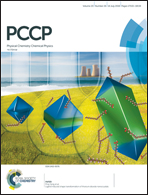On the measurement of relaxation times of acoustic vibrations in metal nanowires†
Abstract
The mechanical resonances of metal nanostructures are strongly affected by their environment. In this paper the way the breathing modes of single metal nanowires are damped by liquids with different viscosities was studied by ultrafast pump–probe microscopy experiments. Both nanowires supported on a glass substrate and nanowires suspended over trenches were investigated. The measured quality factors for liquid damping for the suspended nanowires are in good agreement with continuum mechanics calculations for an inviscid fluid that assume continuity in stress and displacement at the nanowire–liquid interface. This shows that liquid damping is controlled by radiation of sound waves into the medium. For the nanowires on the glass surface the quality factors for liquid damping are approximately 60% higher than those for the suspended nanowires. This is attributed to a shadowing effect. The nanowires in our measurements have pentagonal cross-sections. This produces two different breathing modes and also means that one of the faces for the supported nanowires is blocked by the substrate, which reduces the amount of damping from the liquid. Comparing the supported and suspended nanowires also allows us to estimate the effect of the substrate on the acoustic mode damping. We find that the substrate has a weak effect, which is attributed to poor mechanical contact between the nanowires and the substrate.

- This article is part of the themed collection: 2018 PCCP HOT Articles


 Please wait while we load your content...
Please wait while we load your content...
